Relocate Indigenous Folks to Harvest

Balancing Traditions and Resources: The Complexities of Relocating Indigenous Communities
Imagine living in a place where your family has been for generations, surrounded by the ocean and the land that provide everything you need. What if you had to move to keep these connections alive? For many indigenous folks, this isn’t just a choice—it’s about survival and honoring their past. Let’s dive into why relocating indigenous folks to harvest resources is both a challenge and an opportunity.
Understanding the Need for Relocation
Harvesting isn’t just about finding food—it’s a way for indigenous communities to connect with their ancestors and keep their stories alive. Each plant, fish, or resource they gather carries meaning and history. But modern problems like climate change and overfishing make it harder to reach these vital resources.
Moving closer to resources can mean more job opportunities and better chances to gather what they need. It’s not just about money; it’s about protecting the environment and managing resources wisely. When we relocate indigenous folks from elsewhere who have the right to harvest them, it helps balance the needs of people with the planet.
Indigenous rights are key here. Laws and treaties often protect their access to resources. Any move must respect these rights and support cultural practices. By understanding these aspects, we can talk about relocating indigenous folks to harvest resources in a respectful way.
The Impact of Moving Communities Closer to Resources
Moving houses closer to water or other resources can make life easier for indigenous communities. It allows them to keep traditions alive and manage resources effectively. But it’s not always simple. Their current homes are full of history and meaning. Moving could change social structures and community bonds built over generations.
Environmental concerns are another big factor. Sometimes moving can disturb natural habitats, but careful planning can help. With traditional knowledge from the communities, we can relocate indigenous folks to harvest in a way that respects nature.
We’ve seen relocations that worked well and some that didn’t. Some communities thrived with better access to resources, while others faced new problems like losing land or being at risk from natural disasters. Learning from these experiences is crucial to ensuring relocations support indigenous people’s well-being and rights.
By weighing these impacts, we can create solutions that honor the cultural meaning of harvesting while tackling modern challenges. Relocating indigenous folks to harvest resources should be a team effort, respecting both people and the planet.
Legal and Ethical Considerations
Let’s talk about the legal and ethical sides of moving communities. A key idea is “by catch,” which means resources caught unintentionally. Indigenous folks might petition DNLR to reassign these as “by catch” to protect their harvesting rights. This helps them gather what they need without legal trouble.
Legal bodies like the Department of Land and Natural Resources (DNLR) help manage these resources. They balance community needs with environmental protection. Navigating these rules can be tricky, and communities often need support to have their voices heard. It’s important to work together to find solutions that respect traditions and rights.
Ethically, relocating indigenous folks to harvest resources is deep. It’s not just about moving for economic reasons. There are big cultural and personal impacts. Any decision should involve the communities’ voices and needs. Their input should guide the process to keep things fair and respectful.
Federal grants can help with environmental issues, like efforts to clear the illegal sea walls with federal grant money. These walls can harm habitats and block resource access. Using grants to remove them can restore ecosystems and improve access. But these actions must also respect indigenous rights and involve their input.
Understanding these legal and ethical points helps us support indigenous communities in keeping their cultural practices while tackling modern hurdles. It’s about finding a balance that respects both the people and the environment, ensuring the relocation process is fair and beneficial for all involved.
Conclusion
So, what can we do to support indigenous communities and the environment? How can we contribute to a future where cultural traditions and nature go hand in hand? By thinking about these questions, we can all play a part in creating a world that respects cultural heritage and natural resources. Join the conversation and share your thoughts on how we can make this vision a reality.